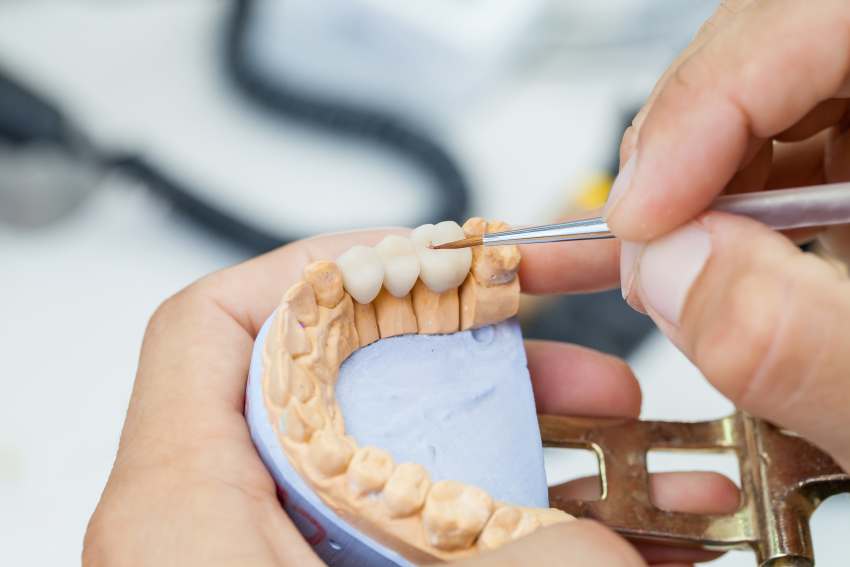Ever woken from a nightmare about your teeth falling right out of your mouth? If so, you’re far from alone: research suggests this is the second most common dream in the world, and it’s the number one dream here in Canada.
While dream analysts still debate about the potential meaning of these dreams, it’s safe to say that having real missing teeth can be a real nightmare!
Gaps between your teeth can wreak havoc on your oral health, and they can even make you hide your smile.
That’s where dental bridges come in. These custom tooth replacements can help you get back the look of your smile while protecting the rest of your teeth. But what are these dental tools, and when do you need them?
Let’s take a look at everything you need to know about dental bridges.
What Is a Dental Bridge?
As the name suggests, dental bridges help to “bridge” any gaps between the teeth in your mouth. These custom-made tooth replacements can include one or more artificial teeth.
Dental crowns on either side of the missing tooth (or teeth) help to support the new artificial tooth. Your dentist will cement both the crowns and the bridges in place to avoid movement.
Like most types of dental work, bridges are most often made to match the shade of your natural teeth. However, you can also get them in the same range of materials you’d get for dental fillings, including silver or gold.
Do You Need a Dental Bridge?
Missing teeth are no small matter! Your teeth have to work in tandem to help you do everyday things like eating, biting, speaking, or smiling.
Worse, when a gap exists between your teeth, the neighboring teeth can sometimes shift to fill it. This can sometimes cause them to become crooked or even to move out of place. If teeth are missing for a long period, it can also lead to serious bone loss in the jaw, which can alter the appearance of your lips and cheeks.
Replacing a missing tooth or teeth with a dental bridge is the best way to help preserve the rest of your teeth as well as your facial bone structure.
What Types of Bridges Are There?
During your appointment with at our North York dental clinic, your dentist will decide between the four types of bridges available to you based on your needs:
Traditional Dental Bridge
The most common type of dental bridge, traditional bridges include a false tooth that the neighboring abutment teeth help to hold in place. If you have natural teeth on both sides of a gap, this procedure is often the first one a dentist will recommend.
Cantilever Bridge
With this type of dental bridge, only one tooth holds the bridge in place. Cantilever bridges are common when a patient has only one natural tooth next to the missing tooth gap.
Maryland Dental Bridge
A Maryland dental bridge is similar to a traditional bridge in that it connects to the two abutment teeth beside the gap. However, where the traditional bridge uses crowns to keep the teeth connected, a Maryland dental bridge adheres to the backs of the abutment teeth using either metal or porcelain. This type of bridge is often preferred for missing front teeth.
Implant-supported Bridge
As the name suggests, these bridges use implants instead of natural teeth for support. This may happen if the teeth next to your gap are implants already, or if our dentist needs to insert new implants to hold a bridge in position. Implant-supported bridges can be helpful when you have multiple missing teeth, and they are very secure.
What Is a Dental Bridge Procedure Like?
In many cases, patients need two or more appointments to complete the dental bridge. The timeline depends on how complex the bridge will be.
First, our North York dentist will take an impression of your teeth. This will create a model that can be used when creating your custom bridge. In the meantime, you’ll get a temporary bridge to protect your teeth while you’re waiting for the creation of your permanent bridge.
The dentist will then reshape the abutment teeth to either side of the missing tooth. They’ll remove some of the enamel and dentin to prepare for the bridge attachment.
When it’s time for the placement of your custom bridge, the dentist will remove your temporary bridge, check the fit of your new bridge, and cement it in place.
You may need to return to our dental office for adjustments after the bridge sets. This can help ensure a good fit and a comfortable bite.
Note that although you may feel slight pinches as our dentist works, this should be a pain-free procedure. You’ll receive a local anesthetic to help numb the area, but you should let the dentist know if you feel any pain or discomfort.
Are There Alternatives to Dental Bridges?
If you’re struggling with a missing tooth, don’t forget that bridges aren’t the only option available to you.
Some patients prefer to use partial dentures, which are removable false teeth that mimic the look of your natural teeth. Other patients opt for dental implants, which are tooth replacements that your dentist inserts into your jawbone to replace the missing tooth at the root.
Our dentist may advise you to get dentures, implants, or bridges depending on factors like the location of your missing tooth and the condition of your jawbone.
Trust Us with Your Dental Bridges
Ready to replace your missing teeth and earn back your smile? Don’t just search “dentist near me” and choose the first name that comes up! Instead, trust our oral health experts to help.
Located just north of the Downsview Subway Station, our office serves patients throughout North York, and we’d be happy to help you! If you have any lingering questions about bridges, or if you’re not sure whether they’re the right dental solution for you, get in touch with us today.

